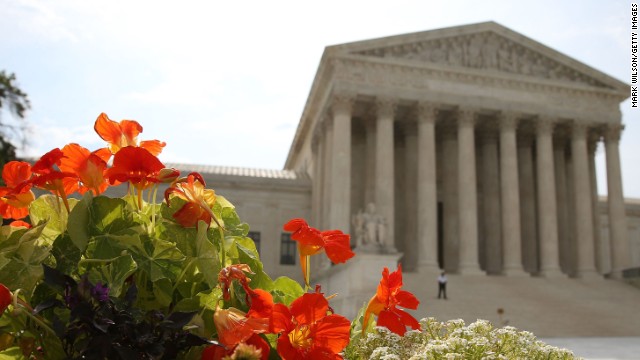
In essence, the court decides if laws and government actions are constitutional and outlines the breadth and limits of government.
When a case reaches the Supreme Court, typically through a process of several years, it’s important because the precedent the majority opinion sets is then the standard by which future laws are measured. That’s due to the principle of “stare decisis,” Latin for “to stand by a decision,” where a current court should be bound by previous rulings.
Are Supreme Court decisions final?
Yes, in the sense that they can’t be overturned by another body.
Can Congress overrule decisions?
Not directly, but Congress can pass laws that respond to rulings.
What about amending the Constitution?
The Supreme Court interprets the Constitution, so amending the document changes how the court is able to rule. But amending the Constitution is a herculean political task requiring, in theory, mass public support, which doesn’t exist for either party at the moment.
Are Supreme Court justices elected?
No. They’re appointed by the president, and then sent to the Senate to be confirmed.
How many justices are there and who appointed them?
Nine. Each has an equal vote.
Chief Justice John Roberts (George W. Bush, 2005).
Justice Clarence Thomas (George H.W. Bush, 1991).
Justice Samuel Alito (GWB, 2006).
Justice Sonia Sotomayor (Barack Obama, 2009).
Justice Elena Kagan (Obama, 2010).
Justice Neil Gorsuch (Donald Trump, 2017).
Justice Brett Kavanaugh (Trump, 2018).
Justice Amy Coney Barrett (Trump, 2020).
Justice Ketanji Brown Jackson (Joe Biden, 2022).
Why do some presidents get to appoint more than others?
Luck and politics. Presidents Bill Clinton, George W. Bush and Obama each served for eight years and got two justices confirmed each.
Are there any requirements to be a justice?
No. It’s most common for nominees to now have strong legal pedigrees (Ivy League law school, experience clerking for previous justices or experience on federal appeals courts) but none of that is required.
Kagan was a Harvard Law professor and solicitor general (a top Justice Department attorney) but was never a judge. The late Chief Justice Earl Warren had been the governor of California.
Are Supreme Court justices appointed for life?
Yes, as are the judges for other federal courts, and they can serve until death or retirement. It means they’re in theory insulated from the whims of the political branches. But it doesn’t make the justices popular: Current polls show that fewer than one-third of Americans have confidence in the court.
Can Supreme Court justices be removed?
Yes, via impeachment — the same process used to remove a US president. The House would vote to impeach, and the Senate would have a trial and vote on whether to remove the justice. It’s never happened for a Supreme Court justice, however.
What is ‘court packing’?
The Constitution doesn’t say how many justices the court must have, but the number has been set at nine since the mid-19th century and codified into law since. In theory, the president can nominate and the Senate can confirm more justices to swing the court in a desired direction.
How does the court work?
The Supreme Court first met in 1790, as the highest court in the judicial branch of government. The justices are led by the chief justice of the United States (that’s the official title). The court has occupied its current building in Washington only since 1935. Previously, it borrowed space in Senate chambers in the US Capitol.
Traditionally, each term begins the first Monday in October, and final opinions are usually issued by late June. Justices divide their time between “sittings,” where they hear cases and issue decisions, and “recesses,” where they meet in private to write their decisions and consider other business before the court.
In the courtroom, justices are seated by seniority, with the chief justice in the middle and the junior-most justices on the outside. Before public arguments and private conferences, where decisions are discussed, the nine members all shake hands as a show of harmony of purpose.
As the gavel sounds and the justices are seated, the marshal shouts the traditional welcome, which reads: “Oyez! Oyez! Oyez! All persons having business before the honorable, the Supreme Court of the United States, are admonished to draw near and give their attention, for the court is now sitting. God save the United States and this honorable court.”
Since most cases involve appellate review of decisions by other courts, there are no juries or witnesses, just lawyers from both sides addressing the bench. The arguments usually last about an hour, and lawyers from both sides very often have their prepared oral briefs interrupted by pointed questions from justices. In recent years, the court has given each justice five minutes to ask questions, going in order from the chief justice to the most junior.
This give-and-take, question-and-answer repartee requires lawyers to think concisely and logically on their feet. And the tone of the questioning often gives insight into a justice’s thinking, a barometer of his/her decision-making.
After the arguments, conferences are scheduled, where justices discuss and vote on the cases. In these closed-door sessions, the nine members are alone. No clerks or staff are allowed. No transcripts are kept.
Justices spend much of their time reviewing the cases and writing opinions. And they must decide which cases they will hear in open court. When asked just before her 2006 retirement what the jurists do most of the time, Justice Sandra Day O’Connor said bluntly, “We read. We read on average 1,500 pages a day. We read. Sometimes we write.” Added Justice Antonin Scalia: “We try to squeeze in a little time for thinking.”
CNN’s Bill Mears contributed to this report.
